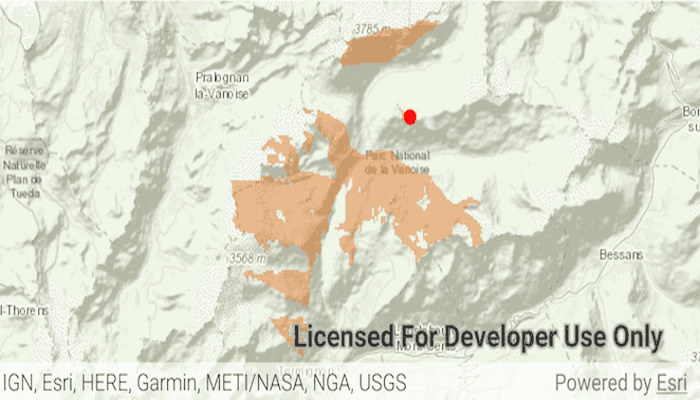Calculate a viewshed using a geoprocessing service, in this case showing what parts of a landscape are visible from points on mountainous terrain.

Use case
A viewshed is used to highlight what is visible from a given point. A viewshed could be created to show what a hiker might be able to see from a given point at the top of a mountain. Equally, a viewshed could also be created from a point representing the maximum height of a proposed wind turbine to see from what areas the turbine would be visible.
How to use the sample
Tap on the map to see all areas visible from that point within a 15km radius. Tapping on an elevated area will highlight a larger part of the surrounding landscape. It may take a few seconds for the task to run and send back the results.
How it works
- Create a
GeoprocessingTaskobject with the URL set to a geoprocessing service endpoint. - Create a
FeatureCollectionTableobject and add a newFeatureobject whose geometry is the viewshed's observerPoint. - Make a
GeoprocessingParametersobject passing in the observer point. - Use the geoprocessing task to create a
GeoprocessingJobobject with the parameters. - Start the job and wait for it to complete and return a
GeoprocessingResultobject. - Get the resulting
GeoprocessingFeaturesobject. - Iterate through the viewshed features to display the geometry in a new
Graphicobject.
Relevant API
- FeatureCollectionTable
- GeoprocessingFeatures
- GeoprocessingJob
- GeoprocessingParameters
- GeoprocessingResult
- GeoprocessingTask
Tags
geoprocessing, heat map, heatmap, viewshed
Sample Code
/* Copyright 2017 Esri
*
* Licensed under the Apache License, Version 2.0 (the "License");
* you may not use this file except in compliance with the License.
* You may obtain a copy of the License at
*
* http://www.apache.org/licenses/LICENSE-2.0
*
* Unless required by applicable law or agreed to in writing, software
* distributed under the License is distributed on an "AS IS" BASIS,
* WITHOUT WARRANTIES OR CONDITIONS OF ANY KIND, either express or implied.
* See the License for the specific language governing permissions and
* limitations under the License.
*
*/
package com.esri.arcgisruntime.sample.viewshedgeoprocessing;
import java.util.ArrayList;
import java.util.List;
import java.util.concurrent.ExecutionException;
import android.graphics.Color;
import android.os.Bundle;
import android.util.Log;
import android.view.MotionEvent;
import android.view.View;
import android.widget.Toast;
import androidx.appcompat.app.AppCompatActivity;
import com.esri.arcgisruntime.ArcGISRuntimeEnvironment;
import com.esri.arcgisruntime.concurrent.Job;
import com.esri.arcgisruntime.concurrent.ListenableFuture;
import com.esri.arcgisruntime.data.Feature;
import com.esri.arcgisruntime.data.FeatureCollectionTable;
import com.esri.arcgisruntime.data.FeatureSet;
import com.esri.arcgisruntime.data.Field;
import com.esri.arcgisruntime.geometry.GeometryType;
import com.esri.arcgisruntime.geometry.Point;
import com.esri.arcgisruntime.loadable.LoadStatus;
import com.esri.arcgisruntime.mapping.ArcGISMap;
import com.esri.arcgisruntime.mapping.BasemapStyle;
import com.esri.arcgisruntime.mapping.Viewpoint;
import com.esri.arcgisruntime.mapping.view.DefaultMapViewOnTouchListener;
import com.esri.arcgisruntime.mapping.view.Graphic;
import com.esri.arcgisruntime.mapping.view.GraphicsOverlay;
import com.esri.arcgisruntime.mapping.view.MapView;
import com.esri.arcgisruntime.symbology.FillSymbol;
import com.esri.arcgisruntime.symbology.SimpleFillSymbol;
import com.esri.arcgisruntime.symbology.SimpleMarkerSymbol;
import com.esri.arcgisruntime.symbology.SimpleRenderer;
import com.esri.arcgisruntime.tasks.geoprocessing.GeoprocessingFeatures;
import com.esri.arcgisruntime.tasks.geoprocessing.GeoprocessingJob;
import com.esri.arcgisruntime.tasks.geoprocessing.GeoprocessingParameters;
import com.esri.arcgisruntime.tasks.geoprocessing.GeoprocessingResult;
import com.esri.arcgisruntime.tasks.geoprocessing.GeoprocessingTask;
public class MainActivity extends AppCompatActivity {
private static final String TAG = MainActivity.class.getSimpleName();
private MapView mMapView;
private GeoprocessingTask mGeoprocessingTask;
private GeoprocessingJob mGeoprocessingJob;
private GraphicsOverlay mInputGraphicsOverlay;
private GraphicsOverlay mResultGraphicsOverlay;
// objects that implement Loadable must be class fields to prevent being garbage collected before loading
private FeatureCollectionTable mFeatureCollectionTable;
private View mLoadingView;
@Override
protected void onCreate(Bundle savedInstanceState) {
super.onCreate(savedInstanceState);
setContentView(R.layout.activity_main);
// authentication with an API key or named user is required to access basemaps and other
// location services
ArcGISRuntimeEnvironment.setApiKey(BuildConfig.API_KEY);
mInputGraphicsOverlay = new GraphicsOverlay();
mResultGraphicsOverlay = new GraphicsOverlay();
// inflate MapView and the LoadingView from layout
mMapView = findViewById(R.id.mapView);
mLoadingView = findViewById(R.id.loadingView);
// create a map with a topographic basemap
ArcGISMap map = new ArcGISMap(BasemapStyle.ARCGIS_TOPOGRAPHIC);
// set the map to be displayed in this view
mMapView.setMap(map);
mMapView.setViewpoint(new Viewpoint(45.3790, 6.8490, 100000));
// renderer for graphics overlays
SimpleMarkerSymbol pointSymbol = new SimpleMarkerSymbol(SimpleMarkerSymbol.Style.CIRCLE, Color.RED, 10);
SimpleRenderer renderer = new SimpleRenderer(pointSymbol);
mInputGraphicsOverlay.setRenderer(renderer);
int fillColor = Color.argb(120, 226, 119, 40);
FillSymbol fillSymbol = new SimpleFillSymbol(SimpleFillSymbol.Style.SOLID, fillColor, null);
mResultGraphicsOverlay.setRenderer(new SimpleRenderer(fillSymbol));
// add graphics overlays to the map view
mMapView.getGraphicsOverlays().add(mResultGraphicsOverlay);
mMapView.getGraphicsOverlays().add(mInputGraphicsOverlay);
mGeoprocessingTask = new GeoprocessingTask(getString(R.string.viewshed_service));
mMapView.setOnTouchListener(new DefaultMapViewOnTouchListener(getApplicationContext(), mMapView) {
@Override
public boolean onSingleTapConfirmed(MotionEvent e) {
android.graphics.Point screenPoint = new android.graphics.Point(Math.round(e.getX()), Math.round(e.getY()));
Point mapPoint = mMapView.screenToLocation(screenPoint);
addGraphicForPoint(mapPoint);
calculateViewshedAt(mapPoint);
return super.onSingleTapConfirmed(e);
}
});
}
/**
* Adds a graphic at the chosen mapPoint.
*
* @param point in MapView coordinates.
*/
private void addGraphicForPoint(Point point) {
// remove existing graphics
mInputGraphicsOverlay.getGraphics().clear();
// new graphic
Graphic graphic = new Graphic(point);
// add new graphic to the graphics overlay
mInputGraphicsOverlay.getGraphics().add(graphic);
}
/**
* Uses the given point to create a FeatureCollectionTable which is passed to performGeoprocessing.
*
* @param point in MapView coordinates.
*/
private void calculateViewshedAt(Point point) {
// display the LoadingView while calculating the Viewshed
mLoadingView.setVisibility(View.VISIBLE);
// remove previous graphics
mResultGraphicsOverlay.getGraphics().clear();
// cancel any previous job
if (mGeoprocessingJob != null) {
mGeoprocessingJob.cancelAsync();
}
List<Field> fields = new ArrayList<>(1);
// create field with same alias as name
Field field = Field.createString("observer", "", 8);
fields.add(field);
// create feature collection table for point geometry
mFeatureCollectionTable = new FeatureCollectionTable(fields, GeometryType.POINT, point.getSpatialReference());
mFeatureCollectionTable.loadAsync();
// create a new feature and assign the geometry
Feature newFeature = mFeatureCollectionTable.createFeature();
newFeature.setGeometry(point);
// add newFeature and call performGeoprocessing on done loading
mFeatureCollectionTable.addFeatureAsync(newFeature);
mFeatureCollectionTable.addDoneLoadingListener(() -> {
if (mFeatureCollectionTable.getLoadStatus() == LoadStatus.LOADED) {
performGeoprocessing(mFeatureCollectionTable);
}
});
}
/**
* Creates a GeoprocessingJob from the GeoprocessingTask. Displays the resulting viewshed on the map.
*
* @param featureCollectionTable containing the observation point.
*/
private void performGeoprocessing(final FeatureCollectionTable featureCollectionTable) {
// geoprocessing parameters
final ListenableFuture<GeoprocessingParameters> parameterFuture = mGeoprocessingTask.createDefaultParametersAsync();
parameterFuture.addDoneListener(() -> {
try {
GeoprocessingParameters parameters = parameterFuture.get();
parameters.setProcessSpatialReference(featureCollectionTable.getSpatialReference());
parameters.setOutputSpatialReference(featureCollectionTable.getSpatialReference());
// use the feature collection table to create the required GeoprocessingFeatures input
parameters.getInputs().put("Input_Observation_Point", new GeoprocessingFeatures(featureCollectionTable));
// initialize job from mGeoprocessingTask
mGeoprocessingJob = mGeoprocessingTask.createJob(parameters);
// start the job
mGeoprocessingJob.start();
// listen for job success
mGeoprocessingJob.addJobDoneListener(() -> {
// hide the LoadingView when job is done loading
mLoadingView.setVisibility(View.GONE);
if (mGeoprocessingJob.getStatus() == Job.Status.SUCCEEDED) {
GeoprocessingResult geoprocessingResult = mGeoprocessingJob.getResult();
// get the viewshed from geoprocessingResult
GeoprocessingFeatures resultFeatures = (GeoprocessingFeatures) geoprocessingResult.getOutputs()
.get("Viewshed_Result");
FeatureSet featureSet = resultFeatures.getFeatures();
for (Feature feature : featureSet) {
Graphic graphic = new Graphic(feature.getGeometry());
mResultGraphicsOverlay.getGraphics().add(graphic);
}
} else {
String error = "Geoprocessing result failed: " + mGeoprocessingJob.getError().getCause().getMessage();
Toast.makeText(MainActivity.this, error, Toast.LENGTH_LONG).show();
Log.e(TAG, error);
}
});
} catch (InterruptedException | ExecutionException e) {
String error = "Error getting geoprocessing result: " + e.getMessage();
Toast.makeText(MainActivity.this, error, Toast.LENGTH_LONG).show();
Log.e(TAG, error);
}
});
}
@Override
protected void onResume() {
super.onResume();
mMapView.resume();
}
@Override
protected void onPause() {
super.onPause();
mMapView.pause();
}
@Override
protected void onDestroy() {
super.onDestroy();
mMapView.dispose();
}
}